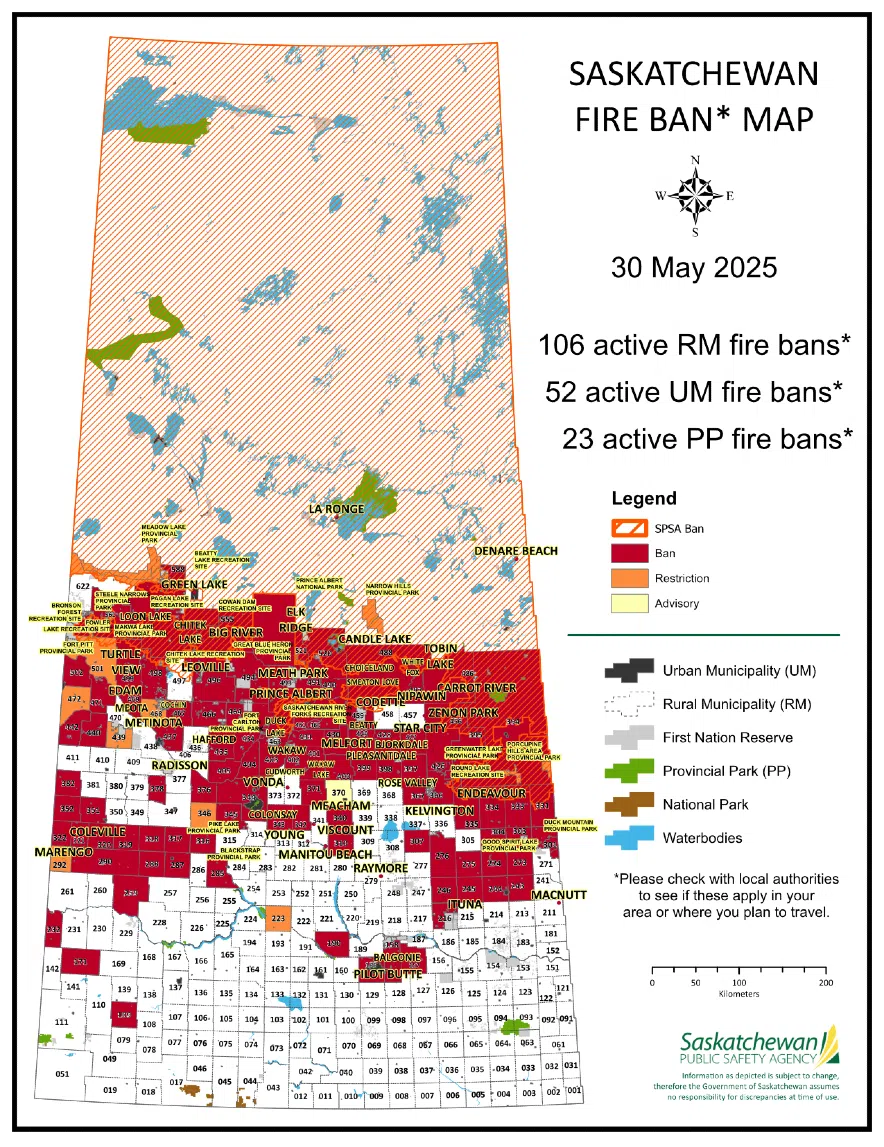The Saskatchewan Public Safety Agency (SPSA) warned people on Friday that things are likely to get worse before they get better as 15 active wildfires were burning in the province.
SPSA’s daily bulletin said that seven of the blazes were not contained and in a briefing on May 30 the agency said it was seeing a major shift in the wind, which has some benefits for some fires but could cause problems for others. It’s also pushing the smoke down south.
On Friday afternoon, people living in the Ramsey Bay subdivision on Weyakwin Lake northeast of Prince Albert National Park were ordered to leave their homes immediately because of a fast-moving fire.
As of May 29, the number of evacuees across the province was around 8,000, according to Marlo Pritchard, President and Fire Commissioner with the SPSA.
He said this number “ebs and flows,” because some people choose to self-evacuate or stay with friends and family.
“Those are the ones that we are aware of being supported (by the SPSA or Red Cross),” he said
Read more:
- Friday wildfire update: Smoke hampering firefighting efforts
- Air quality drops in central, northern Sask. due to wildfire smoke
- ‘This is the time for all hands on deck in this province’: NDP leader Carla Beck

Fire risk in the province on May 30, 2025. (Saskatchewan Public Safety Agency)
Winds a challenge for firefighters
“We are seeing a wind change and a lot of the smoke that has been sitting for the last day or so will be moving south,” Pritchard said.
“I can tell you that in the next 24 to 48 hours, the communities in the south of the province will experience extreme smoke conditions and air quality, probably air quality alerts.”
Smoke is also making battling some blazes a challenge.
Pritchard said smoke from the Club Fire north of Creighton, which is about 25,000 hectares, has restricted some air operations in the area. Thankfully, some helicopters were able to do some work and bucketing on Thursday evening.
Photo of the fire near Flin Flon, from a locked account.
Very sad / scary. Especially as we are still in May. pic.twitter.com/EUc5hQN4WV
— daviskyle.bsky.social (@DavisJKyle) May 29, 2025
He said helicopters continue to work in that area when the smoke allows.
Multiple structures have been lost in the East Trout Lake area, although it might take “a few days” to actually get in there and assess the damage due to smoke conditions and closed roads, Pritchard said.
Steve Roberts, vice president of operations for SPSA, said visibility at their Prince Albert base is no more than two miles.
“From a firefighting point of view, it will reduce the fire activity because things are a little more moderate, but it will prevent us from using aircraft in some situations because of the poor visibility,” Roberts explained.
“We can’t get out ahead of some of these fires to look around again because of the poor visibility, so it will have an impact.”
Air quality affected in in many areas
Air quality statements were issued by Environment and Climate Change Canada (ECCC) for local smoke and reduced visibility many cities across the province on Friday, including Regina, Saskatoon, Lloydminster, Moose Jaw and Prince Albert.
Air quality warnings were issued for areas including Buffalo Narrows, Peter Pond Lake, Candle Lake Prov. Park, Narrow Hills Prov. Park, Cree Lake, Key Lake, Cumberland House, Île à la Crosse, Beauval, Lac la Ronge Prov. Park, La Ronge, Montreal Lake Molanosa and Prince Albert Nat. Park.
ECCC says that air quality and reduced visibility due to wildfire smoke can fluctuate over short distances and can vary considerably from hour to hour.
“Wildfire smoke can be harmful to everyone’s health even at low concentrations,” the alerts say.
“People with lung disease (such as asthma) or heart disease, older adults, children, pregnant people and people who work outdoors are at higher risk of experiencing health effects caused by wildfire smoke.”
ECCC is advising anyone experiencing shortness of breath, wheezing, severe cough, dizziness or chest pains to stop outdoor activities and contact a health care provider.
More information on air quality alerts for specific areas of the province is available at weather.gc.ca. Information is also available on the Saskatchewan Public Service Agency website at saskpublicsafety.ca and the SaskAlert app. The provincial air quality summary for Saskatchewan can be found here.
Roberts said the wind is expected to continue blowing south for the next 36 to 48 hours.
“This would clear up the south and, of course, push that smoke back again to the north,” he said, adding that southern communities can expect to see special air quality statements throughout the weekend.
“They may ask and recommend that people who want to go for the three-mile jog around the park in these conditions defer that because of the amount of smoke in the atmosphere. It’ll be a little more damaging than normal,” he said.
“It will be hazy, it will tend to be a little more hot and humid because the wind is fairly stagnant and, of course, you will smell smoke, as long as it’s coming from the north down to the south.”
The Saskatchewan Roughriders and the CFL are also keeping an eye on the sky ahead Friday’s pre-season game against the Winnipeg Blue Bombers in Regina.
The football club doesn’t anticipate any delays as of Friday at 3 p.m.
Update on the smoke conditions pic.twitter.com/G3OysT366q
— Saskatchewan Roughriders (@sskroughriders) May 30, 2025
Threat of Club Fire reaching communities increased
After a recent drone incident, which grounded air support crews who were battling the Club Fire blaze, the change in wind is causing a new challenge.
“With this wind shift, it will start to get pushed east and then it will be pushed southeast. Unfortunately, that is where Flin Flon, Creighton and Phantom Beach are located, which means the threat of this fire has greatly increased,” Roberts said.
Crews are trying to do what Roberts calls “hardening the lines.”
“We will do as much work on the back side of that fire, knowing that at some point it will turn around and hopefully not have enough fuel to challenge that line and make a significant movement into those communities,” he said.
The SPSA are working closely with local fire departments on those community boundaries to ensure they’re as secure as possible.
As the winds are forecasted to shift from the north to the south on Saturday, the SPSA are watching fires extra closely.
Due to the pattern of southern winds, the SPSA was able to access most of the southern flanks of the fires and secure them.
Shoe Fire expansion risk seen as low
In the case of the Shoe Fire, Roberts said the risk of the fire expanding is low.
“That fire has now basically burned the timber and is at the agricultural land. So it’s actually coming out of the forest — its ability to be a large, volatile forest fire is greatly reduced,” he said.
“Folks who have private ownership and folks who are using pasture land have taken some extra measures to prevent the fire, but it is much easier to manage when it’s not in that heavy forest fuel.”
Roberts said he hopes that by securing the southern flanks of many of the fires, crews can now work on the northern flanks until the winds shift again, which Roberts predicts will be in 48 hours.
Roberts said due to Saskatchewan’s topography, wind is the biggest driver of fire direction and intensity in the province.
“It’s providing extra oxygen to the heated fuel,” he said. “In the event that we get open flames and fires into the trees, it will push that fire through those trees and that’s why we’re seeing these fires move so much.”

Active fires in the province on May 30, 2025.(Saskatchewan Public Safety Agency)
Fires in Saskatchewan on May 30
As well as the seven fires not contained, the province is dealing with three that are contained, four undergoing ongoing assessment and one where SPSA is protecting values.
Contained means suppression action is taking place and the fire is not expected to grow in size, ongoing assessment means the fire is being monitored regularly to assess risk to values in the area and not contained means suppression action is taking place but the fire is expected to grow in size, according to SPSA. Protecting values means a fire is active and action is focused on protecting things like cabins and infrastructure.
As well, fire bans are active in 52 urban municipalities, 106 rural municipalities and 23 provincial parks in the province, with the fire danger considered extreme over most of Saskatchewan.
SPSA says there have been 207 fires in Saskatchewan so far in 2025. The five-year average to date for Saskatchewan wildfires is 127.

Fire bans in the province on May 30, 2025.(Saskatchewan Public Safety Agency)
Read more:











